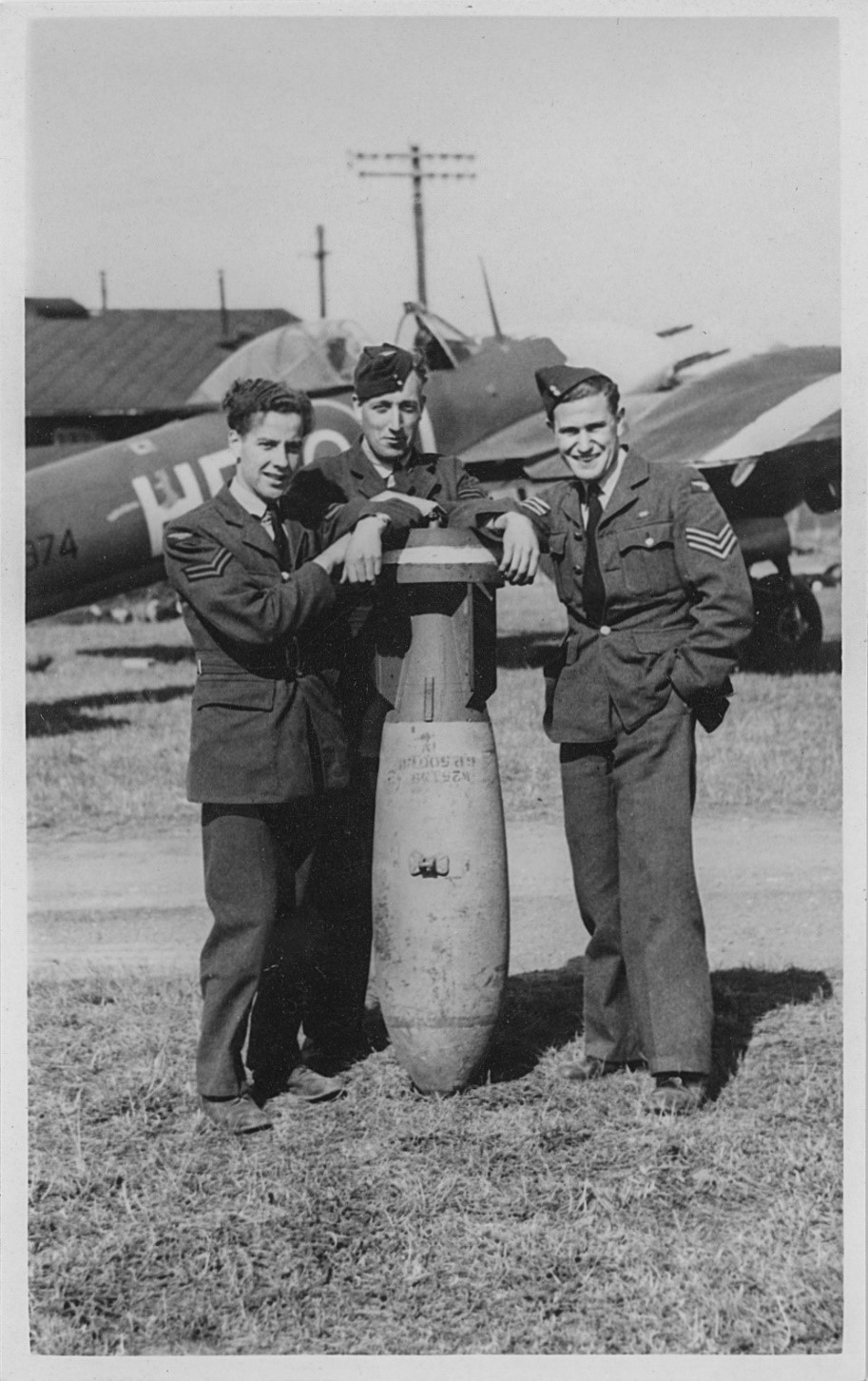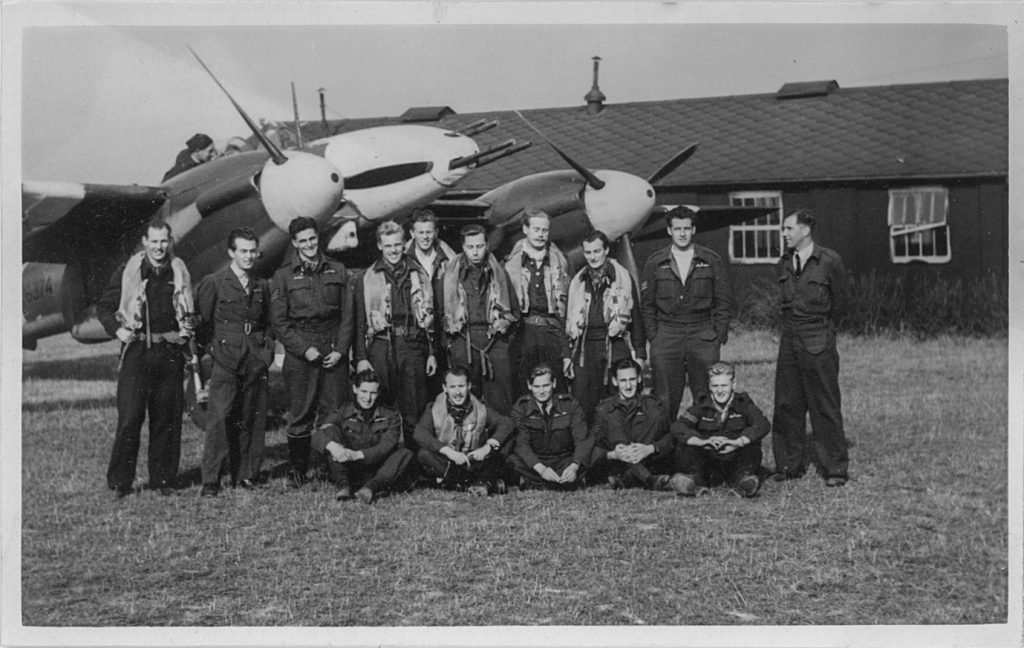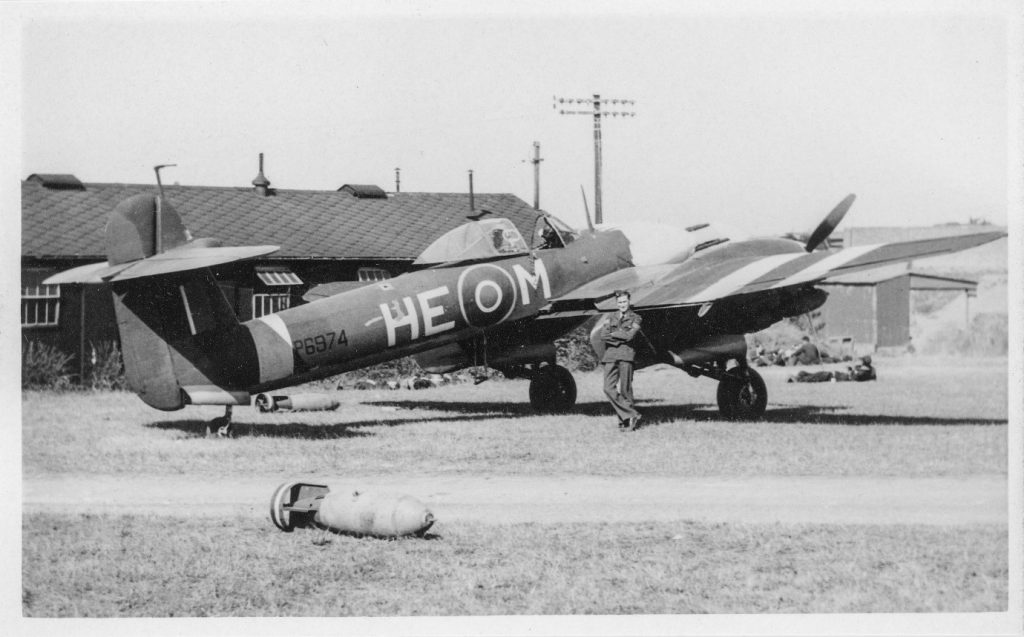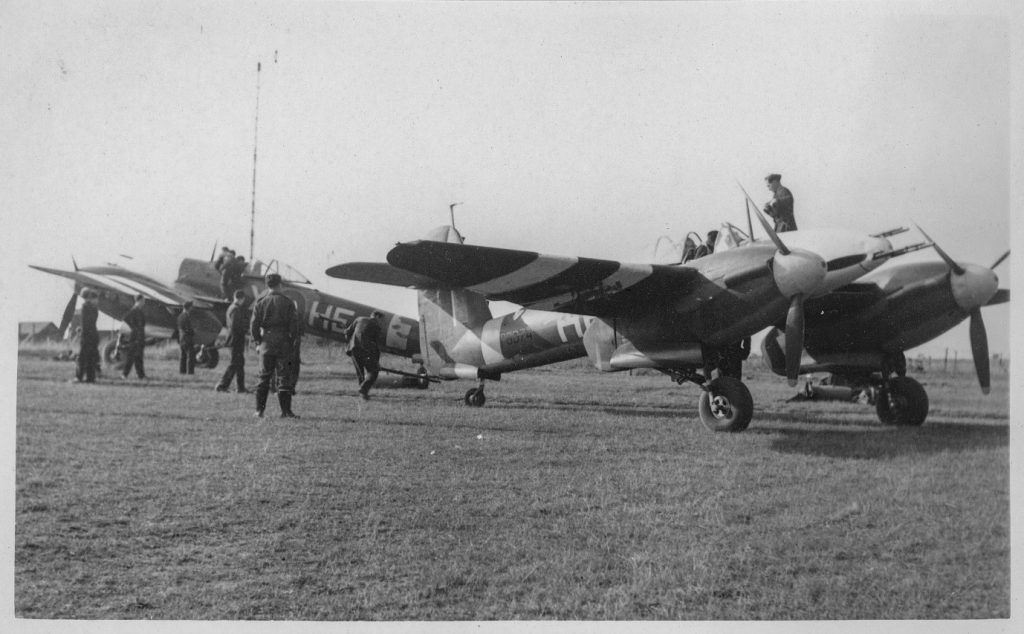Operation Starkey.
From ''The Whirlwind Years' by WFP member Rob Bowater "Fourteen Whirlibombers few to Manston on 7 September to take part in Operation Starkey a large-scale mock invasion of the Pas de Calais. The objectives were to bring the Luftwaffe to battle, and to test the overall German reaction to what hopefully appeared to be a full-scale invasion.
The squadron’s contribution was three attacks against naval guns and heavy flak positions at Hardelot, in order to safeguard ships of the amphibious exercise, Exercise Menagerie, which were to make a feint at Boulogne on 9 September. To avoid confusion, identification markings were applied to all Allied aircraft, the nose of each Whirlwind was painted white whilst the underside of the wings outboard of the engines were painted black with two white bands".

The chap on the right is Joe Hanmore, an Armourer. He went with the Sqn to Europe with the Typhoon.

Back row left to right – Bob Tuff, Paul Mercer, Bob Beaumont, George Wood, John Purkis, John McClure, Reg Baker, Dave Ross, Pete Cooper, Andy Wordsworth (Intelligence Officer). Seated left to right – Denis Todd, Norman Blacklock, Bill Watkins, George Williams, Tommy Handley. Just 8 of these chaps survived the war.
 P6974 HE-M with Joe Hanmore. She was flown by F/L Dave Ross (Flight Commander) during the Starkey Ops.
P6974 HE-M with Joe Hanmore. She was flown by F/L Dave Ross (Flight Commander) during the Starkey Ops.
Taken at the same time, outside the dispersal hut are John McClure, George Williams & Denis Todd.

This photo is one we haven’t seen before but looks to have been taken around the same time as the others.

Here are the entries for Operation Starkey from the ORB:
7th September 1943 - 14 Whirlwinds and the Oxford with the Intelligence Officer to Manston by 1200. This is the Squadron’s first detachment to 11 Group since the famous “escort of bombers to Doel” on the occasion of the Knapsack Raid of 12 August 1941. The CO went to Hornchurch for a conference.
RAF MANSTON
8th September 1943 - 2 more Whirlwinds arrived at Manston making 16 serviceable there. Fine bright day. Briefing for an attack on Naval and heavy flak positions at Hardelot. However, at the last minute tactics were changed by 11 Group to the standard dive-bombing attack. This attack was carried out in the evening by 7 aircraft. Unfortunately, 5 aircraft returned early.
P7096 S/L Ernest Reginald Baker DFC
P7047 F/L John Edward McClure DFC
P6997 F/S William Whittaker Heaton P6983
F/S Harold Medd Proctor P6979
F/S John Barrie Purkis P7040 F/S William Edwin Watkins
P7013 Sgt George Williams
P7055 Sgt Denis Charles Todd
P6974 F/L David George Ross
P7097 F/S George Albert Wood
P7092 Sgt Peter Frederick Cooper
P7056 F/S Robert Charles Beaumont
This Operation, the dive-bombing of Naval and heavy Flak guns at Hardelot was designed to safe-guard the ships of the Amphibious Exercise (Exercise Menagerie) which were to make a feint at Boulogne on the next day.
Unfortunately, 5 of our aircraft returned early, 3 with technical trouble, and 2 with finger trouble.
9th September 1943 - Briefing at 0500 for a further dive-bomb of the Hardelot gun positions. The Operation was then successfully carried out, and the aircraft were quickly re-fuelled and re-armed for further sorties, but these were not called for.
The Squadron was briefed for a dive-bombing attack of St.Omer aerodrome and taxied out at 1710 to take off. This Operation was cancelled in thick and gathering haze. These 3 days at Manston under the auspices of “Operation Lawrence William Fraser Starkey” were very greatly enjoyed by all who took part in the detachment. It may be that the results of the Operation were not those which were hoped for by higher commands. Nevertheless, the sense of having an important part to play in a very large Operation lent a dramatic excitement to Squadron sorties which were in themselves less eventful than our normal dive-bombing Operations in 10 Group.
What it is desired to say here, that, whatever the other results of the Operation may have been, there should also be added on the credit side the roaring good spirits (“excellent morale” is the official phrase) which were engendered in the pilots of this Squadron by the privilege of playing a part in the drama of the preparation and execution of this Operation.
P7096 S/L Ernest Reginald Baker DFC
F/L John Edward McClure DFC
P7012 Sgt William Anthony Handley
P7092 P/O Norman Peter Blacklock
P6974 F/L David George Ross
P7097 F/S George Albert Wood
P7055 F/O Robert Bruce Tuff
P7056 F/S Robert Charles Beaumont
P6986 F/O Paul Thomas Richard Mercer
P6979 F/S John Barrie Purkis
P6947 F/O William Whittaker Heaton
P7013 Sgt Denis Charles Todd
This Operation was a repetition of the dive-bombing of the Hardelot Gun positions. It went well from start to finish. Dives were from 14000 feet to 3500 feet and bombing results were good – all bursts were in the target area, within a circle of 150 yards radius. In both Operations, the coast was crossed at Hastings at 4000 feet, after which the Squadron climbed to 14000 feet,, dive-bombed in echelon starboard and returned in formation at 1000 feet. Target cover was provided by a Typhoon Squadron.
10th September 1943 - The Squadron detachment returned to Warmwell by air and railway. Night Operations were cancelled in an electrical storm and rain.
Again from "The Whirlwind Years: "The ORB noted, ‘This is the squadron’s first detachment to 11 Group since the Knapsack Raid of 12 August 1941.’ During the flight to Manston, S/L Baker lost his airspeed indicator but by formatting on Sgt Todd, he landed safely.The first attack, on the eighth, was escorted by Typhoons. Halfway across the Channel, however, S/L Baker’s port engine and F/L Ross’ R/T failed, but as they pulled out of formation they were mistakenly followed by Sgts Beaumont, Purkis, and Todd. F/L McClure led the remaining aircraft, P/O Heaton, F/S Cooper and Sgts Proctor, Watkins, Wood, and Williams, onto the target, although the results of the attack were not observed.
The second attack ‘went well from start to finish.’ Twelve aircraft bombed in dives from 14,000 feet to 3,500 feet, and all bombs were observed to burst within 150 yards of the target, whilst a third attack, on 9 September, was escorted by 609 Squadron’s Typhoons, and the ORB noted that their pilots were ‘somewhat shocked by the steepness of the Whirlibombers dive.’ S/L Baker’s bombs hung up, and F/L Ross had a constant speed unit fail, but the attack was deemed a success. On their return, the aircraft were re-fuelled and re-armed for an attack against St Omer aerodrome and actually taxied out to take off before the operation was cancelled.
The ORB noted, ‘These three days at Manston under the auspices of “Operation Starkey” were greatly enjoyed by all who took part. Whatever the results, there should also be added on the credit side the roaring good spirits (“excellent morale” is the official phrase) which were engendered in the pilots of this squadron by the privilege of playing a part in the drama of the preparation and execution of this operation. One gun was destroyed and another rendered unserviceable for eight hours.’
On their return to Warmwell, S/L Baker capped a frustrating few days when his aircraft, P7096, hit a ridge, which ripped off the port oleo and wheel and damaged both wingtips. He accepted responsibility, saying that the ‘Ridge was bad but not bad enough to have caused the accident by itself; it was partly due to a heavy landing.’ The diary entry on the tenth noted, ‘The afternoon was spent in removing the zebra stripes bestowed on us for yesterday’s operation. The removal degenerated into a fair scale water fight and everyone got very wet.’
A big thankyou to Rob Bowater for putting together the above piece for us.